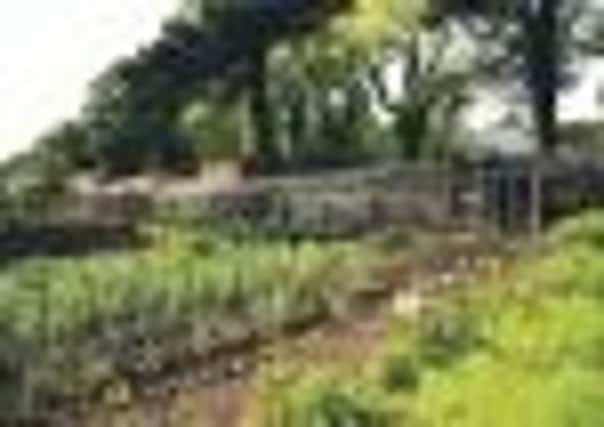Gardening: Duddingston Village Community Garden is a positive sign of the thymes for gardening


THE sign at the entrance to the walled garden is enticing. It asks: “What’s to eat?” before listing an array of vegetables, fruit and herbs ready to be picked and enjoyed. Rows of produce are set out like a market garden at the thriving community plot in Edinburgh. It’s the best of both worlds: grow your own and share it.
Run by volunteers, Duddingston Village Community Garden project is divided into three sections: walled kitchen garden, a gathering space for events, and a work and storage area. Members can volunteer their gardening labour or donate money to help run the group. They can then participate in a garden run for the community – whether to pick the vegetables, learn fruit-growing, help to keep the chickens or just enjoy the space.
Advertisement
Hide AdAdvertisement
Hide AdThe garden comes under the umbrella of Duddingston Village Conservation Society. Lindsay Crofts, the secretary of the society, explains how the garden project works. “There is a community vegetable club that people pay £25 a year to be part of, and this encourages them to take their share. Some users contribute financially to the garden, others donate their time,” she says. Most of the latter have an area of interest they like to concentrate on, whether it’s double-digging the soil, planting onions and garlic, learning how to espalier fruit trees, looking after the chickens or cutting the grass and hedges. Some prefer hard labour, and others take pride in the finer skills, like raising vegetables from seed or pruning fruit trees. There’s someone for each particular job. The garden was part of this year’s Edinburgh entry to Beautiful Scotland in Bloom, the results of which are imminent.
One day a week, a professional gardener is seconded there from her main job at the renowned Dr Neil’s Garden, not far away. Lindsay says: “She keeps us right, for example if someone is weeding and is not quite sure if something should be removed, a note can be left for Claudia to take a look.” Some volunteers can’t spare the time for an allotment and dipping into the community garden allows them to help grow vegetables without huge time commitment. The garden is organic, helped by a composting system of garden waste donated from volunteers’ own gardens. Pests are picked off by hand.
The bottom area, which was a walled garden, was thick with willow, ash and brambles. “We didn’t realise there was a garden there,” says Lindsay. “We did most of the clearance by hand, but had to bring diggers in to the top level. This led to the discovery of brick paths that are now being restored.” The middle section was scrubby grass, but they cut back the bushes and put in seats to make a picnic area. At the centre is a stone base used for bonfire night in November, and there have been many village gatherings.
It’s taken almost a decade to bring the garden up to this standard. The project came about when the land was put up for sale by a local family. The village benefits from a bequest to the National Trust for Scotland by Chrissie McNiven, who was secretary of the conservation society. This bequest has paid for various projects in the area for more than 30 years. In 2000, the society was asked to come up with another project that would be a fitting use of the bequest, and the idea of buying the land for a community garden was born. Since then, volunteers have dug, chopped, sown and mown their way to a garden that gives something back to Duddingston, and is open to visitors.
It doesn’t stop there. The enthusiasm of the community encouraged members to take on the management of a former grazing field uphill from the garden, on lease from the local authority. Members of Duddingston Field Group have planted an orchard and are restoring tree belts. The work was included in a project to plant one million trees for the Diamond Jubilee celebrations. “In one year, we have planted 50 apple trees and planted trees to create habitat corridors for wildlife,” says Nick Marshall, who helped to establish the group. They also want to create a meadow, and willows have been planted for basket-weaving. The field group includes members from the wider city.
Down in the garden, there is plenty on the menu. For starters, broad beans, peas, rocket, turnips, strawberries, raspberries, artichokes, three types of potatoes, spinach, beetroot, lettuce, herbs, and peaches. Extensive lines of vegetables spread out from the stair that connects to the middle garden. Kale, sprouts and other types of brassica are grown in winter as well as leeks. What is grown is a communal decision by the gardeners.
There are also flowers for cutting. A book kept in the shed is the main channel of communication for the volunteer gardeners. They leave a note of what they have done, along with any questions for the paid-for gardener when she arrives. She, in turn, leaves a note of what she has accomplished on her day. A recent attack of potato blight gives an insight into how the garden works and whether or not to use chemicals. “It started a debate about whether to spray – some were against it and others said, we can do this just once,” says Lindsay. The decision of this gardening democracy was not to spray.
• Duddingston Community Garden can be visited daily, 10am-4pm accessed from the Causeway. The field and garden are having an open day on 22 September.